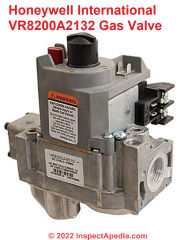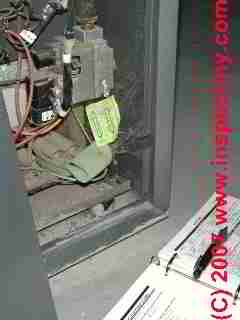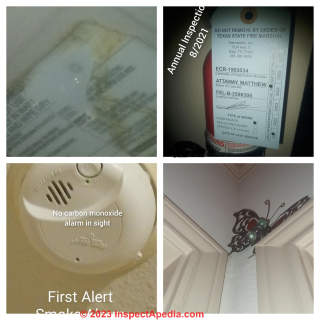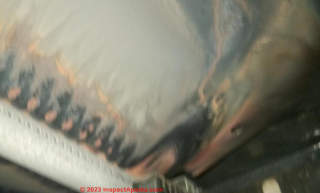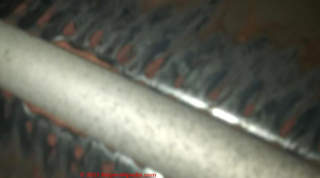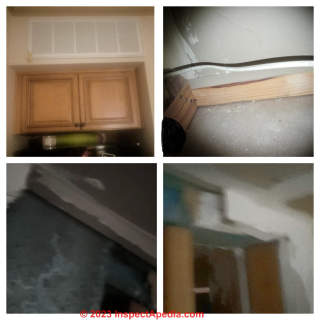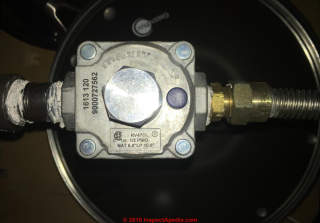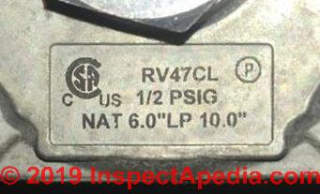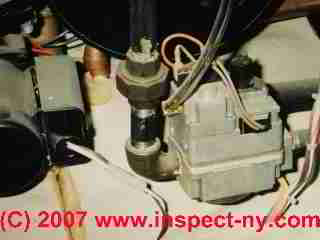 Gas Regulators & Control Valves
Gas Regulators & Control Valves
Functions of gas fired appliances & heating equipment regulators
- POST a QUESTION or COMMENT about inspecting, diagnosing, repairing, or replacing Natural Gas regulators found on heating appliances
Gas appliance control & gas pressure regulators for heaters, water heaters, boilers, furnaces & appliances such as ranges & ovens.
This article explains both LP and "piped-in" or "municipal" Natural Gas Pressure Regulators & Gas Burner Ignition Controls used on building appliances such as gas fired furnaces, boilers, water heaters, and stoves:
We describe how to inspect & test LP or Natural Gas Valves Regulators, or Gas Controls at Appliances. Page top photo: gas burner flame or ignition control & pressure regulator for a gas fueled furnace.
We include descriptions and photographs of unsafe gas piping, regulators, or controls on heating systems, indications of unsafe or improperly operating gas appliances, gas meters, and other gas installation defects.
InspectAPedia tolerates no conflicts of interest. We have no relationship with advertisers, products, or services discussed at this website.
Natural Gas Service & Appliance Regulator Inspection, Testing, & Defect Guide
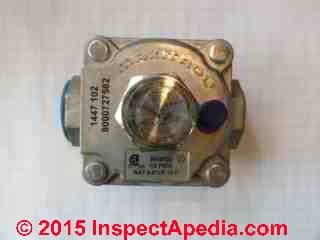
In understanding LP or natural gas regulators used on heaters and other appliances, it's useful to understand how they work, why they are needed, how to inspect regulators on appliances like cookstoves and barbecues, furnaces, space heaters, and water heaters.
Photo: a gas pressure regulator for a gas cook top or range. This control is used on gas-fueled boilers as well as furnaces.
The regulator in the photo is ONLY regulating gas delivery pressure into an appliance - perhaps to a gas cooktop.
[Click to enlarge any image]
But other, larger gas controls found on gas boilers, gas furnaces, and gas water heaters, provide control to
- Turn the gas supply to the heater on or off
- Regulate gas flow and pressure
- For heaters using a standing pilot, the control provides means to ignite the pilot flame; some gas fueled heating equipment use a spark igniter or a hot surface igniter instead of a standing pilot.
See details at GAS PILOT LIGHT PROCEDURE - For water heaters the gas control will also include a temperature control or dial
Below, this Honeywell VR8200 gas valve might be found controlling a gas furnace.
Article Contents
- GAS REGULATORS & APPLIANCE / HEATER CONTROLS - you are on this page
- GAS APPLIANCE REGULATOR REQUIREMENTS
- GAS APPLIANCE REGULATOR FUNCTIONS
- GAS REGULATOR INSTALLATION LP- PROPANE
- GAS REGULATOR DATE CODES & REPLACEMENT SCHEDULE
- GAS APPLIANCE REGULATOR DEFECTS
- GAS APPLIANCE REGULATOR TESTS
- GAS REGULATOR DEBRIS WARNINGS
- GAS REGULATOR PRESSURES, TYPICAL
- GAS WATER HEATER CONTROL VALVES - separate article
- GAS REGULATORS for LP TANKS - separate article for LPG or Propane
Watch out: improper installation and even improper inspection and testing methods involving natural or "LP" gas can involve dangerous conditions and risk fire or explosion.
If you smell gas you should leave the building immediately and should do so without doing anything that could create a spark such as operating a light switch or telephone.
From a safe location, call your gas company's emergency line and/or your fire department.
The gas fired furnace gas regulator photograph shown just above is a typical gas valve assembly such as those used on most household appliances such as gas cooktops and gas ranges.
This gas fuel regulator can be converted to work with either natural gas or LP gas (propane) as we discuss separately
at CONVERT NATURAL GAS to LP GAS / PROPANE.
Why do we Need a Regulator / Gas Control Valve on Natural Gas Systems
 Gas regulators are needed at both LPG or propane gas fueled appliances and at natural gas fueled appliances to assure a smooth delivery of fuel at the pressure and flow rate required by the heater or appliance.
Gas regulators are needed at both LPG or propane gas fueled appliances and at natural gas fueled appliances to assure a smooth delivery of fuel at the pressure and flow rate required by the heater or appliance.
The gas pressure delivered to a heating appliance (gas range, clothes dryer, gas heating furnace, gas fired water heater, etc) needs to be both constant and at the proper pressure for that appliance.
Because of varying outdoor temperatures, the LP gas pressure inside the storage tank may be as low as 10 psi in freezing weather or as high as 200 psi with the tank exposed to sunlight in hot weather.
This article is, however, focused on gas regulators for "piped-in" or natural gas systems.
See GAS REGULATORS for LP TANKS
and LPG PROPANE TANK PRESSURES for more details.
And in natural gas fuel systems the gas pressure delivered from the gas main in the street can also vary widely by area, season, time of day and for other reasons and may range from 60 psi down to as low as 0.25 psi of natural gas pressure in the piping system.
In addition to those external sources of variation in the pressure of the fuel gas supplied to the heater or appliance, the actual gas pressure right at the heating appliance also varies because of gas type (LPG, propane vs natural gas), source pressure variations, gas piping distance, gas piping diameter, and other gas appliances that are in or out of use and fueled by the same building gas piping system.
In sum, a gas appliance regulator must deliver gas at the proper gas pressure and flow rate specified by the manufacturer for the particular appliance.
In addition, at some appliances such as gas fired boilers and furnaces, the job of the gas regulator includes automatically "turning on" the gas when the thermostat calls for heat and turning the gas supply off when the call for heat is satisfied (at the thermostat) OR when a flame sensing safety device or flue gas spillage device detects that the heater is not operating safely.
The LP, propane, or natural gas regulator(s) have to keep gas flowing to the appliance(s) at that pressure even as pressure in the storage tank or gas piping system changes and even when the number of appliances consuming gas changes (as devices turn on and off in the building).
[At above left: the gas pressure regulator for a gas fired heater.]
For that reason the gas regulator will increase the gas flow through itself according to pressure drops on the "low pressure" side of the regulator.
Functions of a Heater or Appliance Gas Regulator / Gas Control Valve
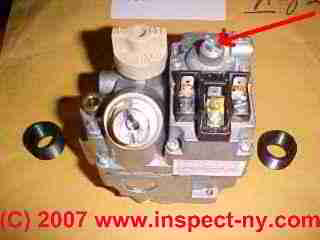 It's impressive how many important functions are often packed into this little gas valve/regulator: The functions that are typically combined in a modern gas valve/regulator include:
It's impressive how many important functions are often packed into this little gas valve/regulator: The functions that are typically combined in a modern gas valve/regulator include:
- On-Off valve for gas:
On automatically-operating heaters such as heating boilers, furnaces and water heaters, the heater's gas regulator incorporates a gas valve that is instructed to open to permit gas to flow into the appliance's burners when the thermostat calls for heat.
The electrical contacts visible at the right front side of the valve in the photo at above left are probably thermostat control contacts. - Safety-shut-off:
If a flame-sensing thermocouple senses that there is no flame the valve will shut in order to prevent sending explosive unburned gas into the building. A thermocouple sensor is placed in the flame path at the burner, and its other end is connected to a safety switch on the valve.
If a thermocouple is used you'll see a small copper tube (or in some devices an electrical wire) connecting the flame sensor to the valve.
The thermocouple and safety shutoff do double duty, since on burners that use a pilot flame the thermocouple senses the pilot flame and won't permit the gas valve to open if the pilot is not lit.
(A bad thermocouple itself can prevent a gas furnace or boiler from working - if you can light the flame at the pilot manually but then the flame goes out when you release the manual gas feed valve, the thermocouple is probably bad.
See THERMOCOUPLE REPAIR / REPLACEMENT. - Gas pressure & flow rate regulation:
The gas valve not only turns the gas on and off to the appliance burner, it also makes sure that gas is delivered at the correct gas pressure at the burners. Gas pressure regulation defects, measurement, and adjustment are discussed in this article series.
For details about the pressures required by gas fueled heaters and appliances
see NATURAL GAS APPLIANCE PRESSURES
or
see LPG & PROPANE APPLIANCE PRESSURES
For details about converting a gas appliance regulator from LP Gas (Propane) to Natural Gas or from Natural Gas to LPG or Propane
see GAS APPLIANCE CONVERT REGULATOR NATURAL GAS-to-LP
For details on how to adjust a typical gas pressure regulator output pressure or flow rate,
see GAS REGULATOR ADJUSTMENT PROCEDURE - Controls or adjustments to permit changing gas fuel type between LP gas and natural gas.
Gas regulators used at or in most appliances can be converted between natural gas and LP gas or propane, but
Watch out: just about every gas heater or appliance that can be converted between types of gas supply will have several changes that must be made at or in the appliance.
Without following the manufacturer's instructions for these changes and adjustments the appliance will not work properly and may be quite unsafe if you connect it to the wrong gas fuel type.
See GAS APPLIANCE CONVERT LP-to-NATURAL GAS for details. - Water heater temperature control.
Gas regulators used on water heaters include a thermostatic control that permits adjusting the hot water temperature within an allowed range set by the manufacturer of the control.
See those gas control valves at
GAS WATER HEATER CONTROL VALVES
The regulator above is shown removed from the appliance where it will be used. The photo of the gas regulator shown at above left and some of the content in this article are thanks to Charles or Mike Trumbature.
Gas Regulator Replacement Schedule: Regulator Date Codes
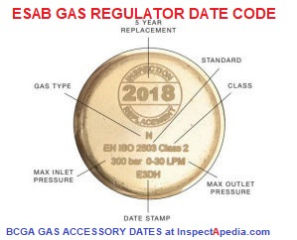 Illustration, the inspect/replace date stamped into an ESAB Gas regulator, excerpted from the BCGA gas accessory date marking documented cited in detail below.
Illustration, the inspect/replace date stamped into an ESAB Gas regulator, excerpted from the BCGA gas accessory date marking documented cited in detail below.
Some but not all gas regulator manufacturers include a date code stamped onto or into the regulator.
Some gas suppliers recommend that best practice is to replace the gas pressure at least 5 years after the date of its production.
Really? Well yes, as we cite PGS below, but in our OPINION practically nobody and certainly very few residential property owners ever replace a gas regulator until it shows signs of malfunction. Is it really necessary or is gas regulator replacement a recommendation from the gas supplier's attorneys?
Note that date codes appear not only on gas pressure regulators but also on other gas equipment such as gas hose connectors and flashback arrestors.
Bottom line: it's best practice (safest) to follow all of the gas piping and regulator safety recommendations from your gas supplier as well as to comply with local plumbing and gas piping codes.
References on Gas Regulator Date Codes & Regulator Replacement
- BCGA, DATE MARKING of GAS ACCESSORIES [PDF] (2018), BRITISH COMPRESSED GASES ASSOCIATION
4a Mallard Way, Pride Park, Derby, UK. DE24 8GX
Company Number: 71798, England
www.bcga.co.uk retrieved 2022/03/19, original source: https://pgstraining.com/wp-content/uploads/2018/05/TIS18-Date-coding-Rev-2018.pdf
Excerpt:
Gas equipment will age and deteriorate over time. Components, such as elastomers and seals, will deteriorate from their date of manufacture whether in gas service or not. This particularly affects accessories, such as pressure regulators, flashback arrestors, flexible hoses and blowpipes attached to mobile systems or gas control systems.
For this type of accessory, manufacturers and / or suppliers will allocate a life for their accessory. Typically in the industrial gases industry this is 5 years - PGS, GAS REGULATOR DATE CODES [PDF] PGS Training.com, The CQA Company
Mere View Barn, Park Ln, Pickmere, Knutsford WA16 0LG, United Kingdom UK, Email:
admin@pgstraining.com, Tel: 01606 872864, retrieved 2022/03/18 original source: https://pgstraining.com/news-articles/understanding-regulator-date-code/
What goes wrong with gas regulators on furnaces or boilers?
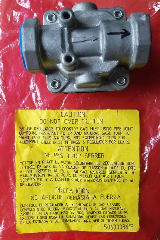 Gas regulator leaks or damage
Gas regulator leaks or damage
Improper installation, including use of wrong type of fittings, improper thread size, cross-threading, or over-tightening fittings at the gas regulator can damage the connectors, pipe or fitting threads or can even crack the gas regulator body. That is going to cause dangerous gas leaks risking fire or explosion.
Be sure to check all fittings and components for gas leaks after converting, installing, or adjusting a gas regulator.
[Click to enlarge any image]
Watch out: typical instructions on the package of a replacement or OEM gas appliance regulator will include this warning:
CAUTION DO NOT OVER-TIGHTEN. Secure regulator to cooktop gas inlet using pipe-joint compound (resistant to LP and natural gas). Turn to hand tight plus 1/4 turn, not exceeding 1 turn for alignment. Check inlet fittings & regulator for leaks. - Maxitrol gas regulator package instructions for Maxitrol RV47CL US 1/2 psig Nat 6.0" LP 10.0"
Gas pressure too high
Some technicians have informed us that as the gas valve regulator on some gas furnaces or boilers age over several years, the spring inside the regulator (and determining the regulator output pressure) can weaken.
A weakened spring inside of a gas regulator can allow the gas pressure to increase beyond the BTU rating of the heat exchanger.
This same condition could occur if the regulator is simply not properly adjusted in the first place. Adjustment of a gas regulator might also be necessary if the gas piping from source (meter or tank) to the appliance is long or is too small in diameter.
If the gas regulator delivers gas at too high a pressure the gas flame may be also too big (and too hot), which can accelerate rusting and can warp the heat exchanger at its lower joints causing a "crack" to appear.
A cracked heat exchanger on a gas appliance is unsafe. Our correspondent, Charles commented that:
After loosing three heat exchangers in two different homes that had routine maintenance inspections, I decided to look into it and check the gas regulator pressure myself. The same problem can occur with gas water heaters.
Gas pressure too low
If the gas regulator is not properly adjusted or if there are other problems in the gas piping or supply system the gas pressure may be too low, providing an inadequate and possibly unsafe flame.
Depending on the cause of the problem, it may be possible to correct this at the regulator, but don't try boosting pressure at a gas regulator unless the pressure has always been too low.
Otherwise when the underlying cause for low gas pressure is corrected elsewhere, the flame will be too big and pressure too high at the burner - an unsafe condition.
Immediate LP or natural gas safety hazards: if there is evidence of an LP or natural gas leak at a building, gas odors, for example, you should:
- Do not do anything that is likely to cause a gas explosion, such as lighting a match, operating an electrical switch, or even using a telephone in the building
- Leave the building immediately
- Notify other building occupants of the safety concern
- Contact the local gas company and/or fire department - calling from a safe location
Gas regulator noises
While many gas grill and some other appliance manufacturers say a bit of humming at the gas regulator for appliances is normal and harmless, not everyone agrees.
Certainly if there is a gas odor or gas leak, the gas supply should be shut off immediately and you need to call a professional for diagnosis and repair of the trouble.
Some experts explain that over time a humming gas regulator may become unsafe; and there are other noises that have other meanings at gas regulators, pipes, and LP gas tanks.
See GAS REGULATOR NOISES for complete details.
Also see
- THE TRUTH ABOUT GAS LEAKAGE COMPLAINTS and GAS VALVES [PDF] - original source: Honeywell Corporation (1994), www.graycoolingman.com/uploads/1/0/6/6/10667336/honeywell_gas_valve_leakage.pdf
How are Gas Regulator Valves Inspected and Pressure-Tested?
Connecting and Using a Gas Pressure Manometer
The pressure delivered to a gas-fired heating boiler or furnace is typically 3" to 3.5" water column for 100K BTU gas fired furnaces or boilers.
(LP gas and piped-in natural gas do not provide the same pressures from the source which is why regulators and orifices must be properly installed and adjusted depending on the type of gas fuel in use (Propane or LP gas from a local gas tank vs. natural or piped-in gas).
The large screw on top of the gas regulator shown in the photograph above is a "cap screw" which can be removed by (a trained) heating technician when it is necessary to access the LP or natural gas pressure regulator adjusting screw inside.
Watch Out: If you lack the training and equipment, do not attempt to disassemble or mess with a gas regulator as you could create a very dangerous or even fatal problem.
Under the "cap screw" on the gas regulator there a plugged NPT tap (usually 1/8") used to install a hose barb and manometer (a very low pressure gage) in order to check gas pressure right at the heating furnace or boiler.
[Gas regulator valves such as this one usually have a 1/8" NPT plug which is remove by the technician in order to connect a manometer to measure the gas pressure being delivered right at the appliance.]
For connecting the manometer to measure gas pressure, the technician may obtain a hose barb and plastic hose form a hardware store in order to make these connections.
The actual gas pressure setting for the regulator is on the gas valve. Inexpensive manometers such as those made by Dywer Instrument CO. are good for checking and setting the regulators.
See the 2T650 and 3T292 models, probably best suited depending on the ranges needed. [Available from Granger Corp., a supplier of HVAC testing equipment.] Since the pressures for gas furnaces (and boilers) can vary above or below the 3" water column (WC), the 7" manometer is probably a better one fits all choices when checking gas regulator assemblies.
Charles, a fire pump and sprinkler system inspector in Houston TX, our correspondent on this topic commented:
One of the things I've noticed about home inspections are the A/C contractors inspecting gas furnaces. They have no problem identifying a cracked heat exchanger but never check the gas pressure to the burner.
Checking the pressure delivered to a furnace by a gas regulator valve is beyond the scope of a normal home inspection. However certain clues such as defects in gas flame or rusty gas burners can suggest that there is a problem with the adjustment of the gas pressure (the regulator's job) or with the combustion air supply (potentially a fatal mistake).
Debris on Gas Regulators or Furnace Burners can be Dangerous
The gas regulator and gas burner photograph shown in this photo has clearly not been inspected, tested, cleaned, measured, nor serviced in some time.
Not only are there dusty cobwebs over the gas regulator, but a chewing gum wrapper and a scrap of green foam have fallen into the furnace and may be blocking air intake to the right hand gas burner tube.
Not only might this interfere with proper burner operation by obstructing combustion air to the burner, but combustible trash at any gas burner is a potential fire hazard.
The gas burner flame color, pattern, height, or the presence of rust
on a gas burner can also indicate potentially dangerous operating problems with a gas furnace or boiler.
These concerns are discussed in more detail
at GAS FLAME & NOISE DEFECTS or select a topic from the closely-related articles below, or see the complete ARTICLE INDEX.
Gas Cylinder or Tank Regulators:
Readers concerned with installing, inspecting, or testing LP Gas regulators which are found on outdoor above ground or buried gas cylinders used for storage of LP Gas on site should also
see GAS REGULATORS for LP TANKS
Readers concerned with changing the fuel type between LP gas and natural gas for a gas fired appliance should see our safety warnings
at GAS APPLIANCE CONVERT LP-to-NATURAL GAS.
Gas Regulator Adjustment
This discussion has moved to GAS REGULATOR ADJUSTMENT PROCEDURE - separate article
Typical Natural Gas Pressures Found in Residential Systems
Example Natural Gas pressures:
- Natural gas in the natural gas service line in the street will be found at pressures from 60 psi down to as low as 0.25 psi.
- 6" water column at the NG appliance regulator inlet - based on Maxitrol RV47CL US 1/2 psig Nat 6.0" LP 10.0"
- At individual natural gas appliances the gas pressure will be regulated to about 0.25 psi [1]
Details about the different pressures found or set for LP gas, propane, and natural gas including before and after different gas pressure regulators are given separately at
at GAS PRESSURES LP vs NATURAL GAS
Gas Regulator Codes, Standards, Research, Manuals
- GAS METER CODES
- GAS PIPING CODES
- GAS REGULATOR CODES
- GAS WATER HEATER CONTROL VALVES - pilot light, gas valve, thermostat for temperature control
- International Fuel Gas Code (2003), Chapter 4 GAS PIPING INSTALLATION CODE [PDF], retrieved 2017/11/12, original source: https://www2.iccsafe.org/states/seattle/seattle_fuelgas/PDFs_fuelgas/Chaper%204.pdf
- NFPA 54, ANSI Z223.1 NATIONAL FUEL GAS CODE [PDF] contents & sections (2012), American Gas Association and NFPA, 1 Batterymarch Park, Quincy, MA 02169-7471
See Chapter 8, Gas Pressure Testing and Inspection, and Gas Piping System Leak Check procedures. - NFPA 54, ANSI Z223.1 NATIONAL FUEL GAS CODE [PDF] (2006) Complete Text, retrieved 2018/01/18, original source: http://bcpad.net/Code%20Books/NFPA%202006.pdf
- ROBERTSHAW 700-SERIES GAS VALVE INSTRUCTION MANUAL [PDF] (2014)191 E. North Avenue
Carol Stream Illinois 60188 USA
Customer Service Telephone 1.800.304.6563
HVACCustomerService@robertshaw.com
For Technical Service Telephone 1.800.445.8299 Facsimile 1.630.260.7294 TechnicalService@robertshaw.com Web: www.robertshaw.com - ROBERTSHAW GAS CONTROL VALVE MANUAL - 700 - 800-Series [PDF]
Excerpt:
The Robertshaw® 700-800 Series gas controls are bleed gas controlled diaphragm valves. The 700-800 thermocouple type diaphragm valves are most commonly used on commercial water heating equipment in conjunction with the 1352 (CWH-3) bleed gas temperature controllers. - Robertshaw 720 SERIES
INTERMITTENT PILOT IGNITION GAS VALVES [PDF]
Excerpt:
The Robertshaw® 720 Series Gas Valves, for use on intermittent pilot ignition systems, are designed for a wide variety of applications.
They incorporate a manual valve, pilot valve, dual automatic valves and a main gas pressure regulator. The 720 valves have their pressure regulators factory pre-set at 3.5” W.C. for natural gas. Uni-Kit models can be converted to L.P. by installing the regulator conversion kit (included). These valves feature wiring connections, manual selector and adjustments that are all easily accessible on top of the valve.
With a 3-9/16” swing radius, the 720 Series lends itself well to replacing many 0.E.M. valves. They are multiposition and can be mounted in any position (except upside down).
Reader Comments, Questions & Answers About The Article Above
Below you will find questions and answers previously posted on this page at its page bottom reader comment box.
Reader Q&A - also see RECOMMENDED ARTICLES & FAQs
On 2023-01-26 by Maria - burning smell & sooting at my gas stove
I can smell a burning smell sometimes like an old fire. Pictures include what I think is thermal ghosting, no carbon monoxide tester, just smoke, windows that I can't open from the bottom, a fire extinguisher that was last inspected in 2021,
a filter that is drenched in some kind of white powder, and a firestop on the range hood that reads "not recommended for gas stoves"
FYI...I have addressed the office here, and the management, they have done nothing. I keep asking for a copy of my lease, 7 months later, still no lease. Advice?
I was cleaning my Kenmore gas stove and I notice something that looked like art work, the kind of art work you see on trains. Is this normal?
more pics to follow...
On 2023-01-26 by Maria - soot around a burner or furnace
I red about Arc Tungsten Welding. I'm on the 3rd floor, no one above. The attic/ mezzanine is above me. I hear movement up there constantly. My return air filter is huge. I went in a took pictures. The 2 on top is what I see when I remove the grill. Sorry they are a bit blurry.
On 2023-01-27 by InspectApedia Publisher - visible soot around a burner or furnace or boiler could be a carbon monoxide hazard (dangerous)
@Maria,
Sorry but we really can't see thermal ghosting in your composite photo.
In our photos of what may be a gas burner we see a bit of corrosion and light sooting in what may be the flame pattern at orifices in a burner tube.
We also see what looks like an advertisement for a photo company - something we don't accept here. So please clarify that stamp on your images.
Finally
Watch out: We DO NOT see this in your photos, but IF gas fueled heating equipment is producing visible soot such as around a burner or furnace or boiler there could be a carbon monoxide hazard (dangerous) - so be sure that you have working carbon monoxide detectors (CO detectors) and smoke detectors properly located, installed, and tested.
On 2022-10-08 by catalina_1200@hotmail.com - natural gas regulator that will be LOW pressure on the SUPPLY side
I am trying to get a natural gas regulator that will be LOW pressure on the SUPPLY side, as I'm removing a space heater in a house and running the low pressure in home natural gas line to the regulator you recommend to run a small generator (champion 1000216 ) Please recommend the correct regulator , thank you
On 2022-10-08 by InspectApedia-911 (mod) - trying to get a natural gas regulator that will be LOW pressure on the SUPPLY side
@catalina_1200,
I'm too nervous about seeing you do something unsafe when I know so little about your installation and also about your plumbing skills. The best bet would be to give the manufacturer or call and talk to their technical support.There's more to the regulator question than just the pressure in the supply piping. Pipe size and distances and the generator's input requirement all need to be considered.
On 2021-10-29 by Terry M - boiler pilot light won't stay on
Heating system gas water boiler worked great all last season. This September the pilot would not light so my HVAC tech tried new thermocouples, to no avail. He then installed a new gas regulator which seemed to do the trick. Pilot lit and boiler ignited. The system produced heat for about a week.
The thermostat indicated on but there was no heat. I checked the boiler, which not ignited, and saw the pilot was off. I did the appropriate pilot lighting procedure and the pilot lit and then the boiler ignited, producing heat. But after an hour or so the thermostat was still "on" but the boiler shut down and the pilot was out.
For the last 5 days I have had to re-light the pilot to get heat. The heat never reaches the temp setting on the thermostat before it shuts off. After producing heat for a while the newly installed regulator gets very warm. BTW, the pilot,. when on, produces a nice blue V shaped flame.
Any ideas?
On 2021-10-29 by inspectapedia.com.moderator - I have had to re-light the pilot to get heat
@Terry M,
After confirming that your system is designed to use a standing pilot (always on)
I'd look for
- improperly-located or installed thermocouple or a bad thermocouple
- improperly located pilot flame
- drafts that blow out the pilot
- variations in gas pressure or blockage in gas piping that drops pressure
On 2021-03-21 by John RS - Should a different regulator be used for gas logs?
My brother-in-law is a plumber and he helped me with connecting a 20 lb propane tank to a copper gas line that runs into the fireplace to supply gas logs. I can get the pilot light to ignite, but opening the valve doesn’t get the burner to ignite. I used a hose and regulator replacement kit for a gas grill to connect the propane tank. There are no leaks.
Should a different regulator be used for gas logs?
On 2021-03-22 by danjoefriedman (mod) - opening the valve doesn’t get the burner to ignite
@John RS,
It's possible that you need to purge air from your gas piping - you may need to leave the valve open for a time and to try repeatedly to light the gas log set.
A clue that your gas supply is working is if you smell gas - if you do and the fireplace still won't ignite, your system may be improperly piped or installed or otherwise unsafe. Or the pilot may not be properly located at the gas supply orifice.
Also check that the thermocouple installation; if the thermocouple is not properly-located and if it's other end is not properly and snugly-connected to the gas valve the gas valve may not open.
See details at THERMOCOUPLE REPAIR / REPLACEMENT
If you don't already have the manual for your gas log fireplace you should download a copy and follow its installation instructions.
That will include the position of the pilot assembly to be sure it's properly located to ignite the gas when you open the gas valve.
GAS LOG FIREPLACE MANUALS
will be of help.
Take a look also at this GAS LOG FIREPLACE SAFETY PILOT CONTROL [PDF] from RealFyre and that works for propane or natural gas log fireplaces - you'll see that it does not anticipate an additional gas pressure regulator at the gas log set.
On 2021-01-26 by Anonymous - where does the gas boiler igniter go?
The spark ignition comes out the front towards the front of the furnace the boiler or the back how is it installed I forgot how I took it out
On 2021-01-27 by danjoefriedman (mod)
Anon:
let's start with the brand and model of your heater; then we can find the manual for it and you can see exactly how the parts should be installed.
I'm a bit nervous about pretending I can tell you how to safely install gas burner components for a system while flying blind: a mistake means the system is unsafe.
On 2020-06-05 by David - propane regulator on a BBQ, leaks when off?
Concerning the propane regulator on a BBQ, if I leave the propane tank open by accident will there still be propane emitted into the bbq even though the burners are off? Please let me know, thank you in advance for your help
On 2020-06-06 - by (mod) -
David
I'm sorry to have to say ... it depends.
IF the individual burner controls are fully OFF
AND IF the controls are working perfectly, not damaged, not leaking
AND IF there are no other leaks in the propane piping, hose, fittings,
THEN sure, no propane would be lost or leaking out to the environment or into the BBQWatch out: in my experience with fixing gas BBQs, some, especially older models, often have leaky control valves- for safety you should ALWAYS turn off the gas supply from the propane tank when the unit is not in use.
On 2020-05-07 by Steven - gas regulator part change when changing fuels: LP <-> Natural Gas
Can a "Robertshaw 700-059 High Capacity Gas Valve 1" 7000DERHC-S7C" valve that is for Natural gas be used with Propane? this application is for a hot water pressure washer (Hotsy) and is a very old unit. thank you!
On 2020-05-07 - by (mod)
Steven:
Quoting the manufacturer:
The pressure regulator is “built-in” on hydraulic models and requires replacement of the operator assembly when converting from one gas to another
See this
ROBERTSHAW 700-SERIES GAS VALVE INSTRUCTION MANUAL [PDF]
Other models can be converted by turning a pointer
REGULATOR CONVERSION OR REPLACEMENT
CAUTION: Main burner and pilot orifices must be changed when regulator is converted from one type of gas to another.
Convertible Regulator Models
700 models with convertible regulators may be converted from Natural gas operation to L.P. gas operation or L.P. gas operation to Natural gas operation.
1. Insert a wide screwdriver blade in slot in converter pointer.
2. Rotate pointer 90° to convert regulator from Natural to L.P. gas operation or L.P. to natural gas operation. The pointer indicates the type gas and 90°pressure at which the converter is set.
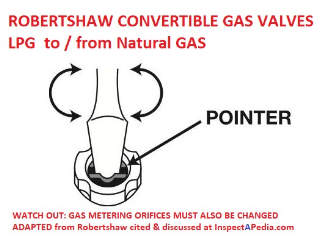
On 2020-05-07 by Steven - which valve to use with propane gas systems?
do you have a recommendation for a different valve to use with propane?
On 2020-05-07 - by (mod) -
Steven
It's not the valve that's going to trip you up - there are plenty of generic ones operating in the pressure range that your old appliance will want;
You have to change the gas orifices too - so contact the manufacturer to see if you can simply buy a conversion kit.
On 2020-05-07 by Steven
thank you very much for your help. due to the document you supplied and a little more digging i have learned the system and now understand exactly how it works. i can now fix my problem without buying a completely new part!
On 2020-05-08 - by (mod) -
So good to hear. Thanks for the follow up.
On 2020-03-12 by kenholtmeyer - can a LPG regulator be converted to nat. gas?
can a lp regulator be converted to nat. gas?
On 2020-03-13 - by (mod) - many but not all gas regulators can be converted between LP gas and Natural Gas
Kent
Many but not all gas regulators can be converted between LPG and natural gas. Often there is a part that is flipped over to change a metering orifice. The regulator is usually stamped or marked if it is convertible, and when you have the manufacturer's brand and model you can in fact find the conversion instructions.
See details at GAS APPLIANCE CONVERT REGULATOR NATURAL GAS-to-LP
On 2020-01-17 by Nick
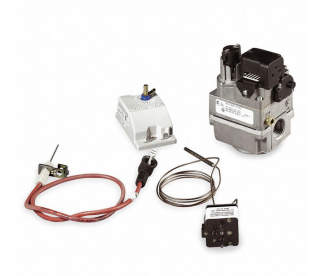 Good Morning, I Just purchased and installed an LP regulator for my outdoor fireplace.
Good Morning, I Just purchased and installed an LP regulator for my outdoor fireplace.
The fire place calls for 8" to 12", the regulator states on it that it provides NAT 4", LP 10". When I turn on the gas the regulator makes a soft pop, and the regulator immediately shuts itself off
If I leave an open butt on the delivery side of the regulator, and slowly crack the valve it stays on until the valve is 2/3 open and then shuts off. (No worries, out side and uphill and only open for a couple seconds.)
I bought two regulators and they both do the same thing. Is the pressure too high coming from my tank too high?
Do I need a pre-regulator regulator? The tank regulator was originally set up to run a generator, pool heater, stove and a couple small water heaters.
Yes, it is a high volume regulator, red in color, but I can't read the numbers on the regulator due to its position on the tank. 250 gallon tank, 42% full.
Everything else seems to work fine. Is there some adjustment on/in the regulator for Nat to LP? Nothing obvious on the regulator.
On 2020-01-18 - by (mod) - gas popping noise when gas is turned on
Nick
The amount of fuel in the LP tank isn't going to affect this problem unless you're in essence out of gas.
It does sound as if perhaps the pressure is too high for the regulator. Given the risk of a fire or explosion, I'd prefer to bring out an LP service tech who can measure pressures and if necessary, install the proper regulators.
Question: In-house gas line is at 2 psi; appliance regulator has max input of 0.5 psi. Is this OK?
Our home was built in 2016. It has a propane gas system regulated to 2 PSIG.
I just noticed that the appliance regulator on the kitchen cooktop says 1/2 PSIG. It is a Maxitrol RV47CL, showing 1/2 PSIG NAT 6.0" LP 10.0".
The cooktop was installed by the appliance provider, not by the gas contractor that did the rest of the gas system work. Is this regulator OK or is it dangerous?
[Click to enlarge any image]
Reply: Maxitrol RV47CL gas regulator operating pressure & Emergency Pressure Limits
The Maxitrol RV47CL expects a maximum inlet pressure of 1/2 psi at the input end of that appliance regulator.
And that's the typical in-house gas line pressure for a 1-family residence; Sometimes a taller or larger building with many appliances will need to run a higher pressure gas line through the building but then the pressure must be stepped down to the inlet pressure wanted by the individual appliances being fueled.
1/2 psi (0.5 psi) INLET PRESSURE at the regulator would be over 55" WC (just for comparison with the outlet pressure given next)
10" WC (inches of water column pressure) = about 0.36 psi - that's the outlet pressure;
2 PSI in your gas piping system delivered to the regulator is, I think, high and improper, though it's below the regulator's "emergency" limit as I'll describe below.
The company's product RV-Series brochure (cited below)notes
Maximum Inlet Pressure .......... 1/2 psi (3.4 kPa)
Emergency Exposure Limits...... 2.5 psi (17.2 kPa)
Watch out: The company doesn't wax eloquent on what "emergency exposure limits" means but I doubt that it's intended to mean "all the time".
The RV47CL should not rupture and leak when temporarily exposed to gas pressures up to 2.5 psi but it also may fail to regulate the gas pressure properly whenever its intended input of 1/2 psi is exceeded.
Continued higher pressure exposure and certainly exposure to higher than Emergency Gas Exposure Limit pressure could also damage the regulator.
Any of those conditions can be UNSAFE risking improper and unsafe appliance operation, a gas leak, fire or worse, explosion. (OK so I may err on the side of caution, constrained by the limits of guessing and trying to keep you safe based on just a brief e-text, there we are).
Elsewhere (e.g. in some boiler manuals using Maxitrol regulators) we read:
At the emergency exposure limits, there may be no regulation, but all models will contain gas. They will suffer no internal damage and will resume regulation when normal pressure is restored.
IMO that means that above 2.5 psi the regulator could leak combustible gas.
Give Maxitrol a call - let me know what you're told as that will help other readers.
- Contact: Maxitrol Company 23555 Telegraph Rd., PO Box 2230 Southfield, MI 48037-2230 USA Tel: 888-757-4774
- MAXITROL GAS REGULATOR RV SERIES BROCHURE RV20, RV47, RV48, CV47 Regulators [PDF] (2015) - free download any of these PDFs
Other Maxitrol Gas Regulator References
- MAXITROL GAS APPLIANCE REGULATORS RV52, RV53, RV61, RV81, RV91, RV111, and RV131 [PDF] (2008)
- MAXITROL LINE PRESSURE REGULATOR GUIDEBOOK for NATURAL GAS [PDF] Op. Cit.
- MAITROL GAS PRESSURE REGULATORS CATALOG [PDF] (2017) Op. Cit.
...
Continue reading at GAS REGULATORS for LP TANKS or select a topic from the closely-related articles below, or see the complete ARTICLE INDEX.
Or see GAS REGULATORS for APPLIANCES FAQs - questions & answers about appliance or heater gas regulators posted originally on this page.
Or see these
Recommended Articles
- CONVERT the GAS ORIFICES - change between LP Propane & Natural Gas; changes for high altitude gas appliance or heater operation
- GAS APPLIANCE CONVERT LP-to-NATURAL GAS
- GAS APPLIANCE CONVERT REGULATOR NATURAL GAS-to-LP
- GAS APPLIANCE OPERATION at HIGH ALTITUDE
- GAS BURNER FLAME & NOISE DEFECTS
- GAS BURNER SOOT CAUSE & CURE
- GAS BURNER PILOT LIGHT PROCEDURE
- GAS BTUH, CUBIC FEET & ENERGY - calculate or convert between cubic feet of gas, liquid gallons of LP gas, and BTUs per cubic foot or gallon of gas fuels.
- GAS PIPING, VALVES, CONTROLS - home
- GAS PRESSURES LP vs NATURAL GAS
- GAS REGULATORS & APPLIANCE / HEATER CONTROLS - home, Natural Gas regulators & appliance regulators, NG & LP
- GAS REGULATOR ADJUSTMENT PROCEDURE
- GAS REGULATOR CONVERSION NG-LP
- GAS REGULATORS for LP TANKS - home, LPG / Propane systems
- GAS REGULATORS, TWO STAGE
- GAS REGULATOR NOISES
- GAS REGULATOR TEST PROCEDURES
- GAS REGULATORS, TWO STAGE
- GAS WATER HEATER CONTROL VALVES - pilot light, gas valve, thermostat for temperature control
- MANUALS for HEATING & A/C SYSTEM CONTROLS - gas burner controls, manuals, instructions, troubleshooting flowcharts
- MERCURY HAZARDS in APPLIANCES & GAS REGULATORS
- WATER HEATER AGE & MANUALS
Suggested citation for this web page
GAS REGULATORS & APPLIANCE / HEATER CONTROLS at InspectApedia.com - online encyclopedia of building & environmental inspection, testing, diagnosis, repair, & problem prevention advice.
Or see this
INDEX to RELATED ARTICLES: ARTICLE INDEX to GAS APPLIANCES, PIPING, CONTROLS
Or use the SEARCH BOX found below to Ask a Question or Search InspectApedia
Ask a Question or Search InspectApedia
Questions & answers or comments about inspecting, diagnosing, repairing, or replacing LP gas regulators and Natural Gas regulators found on heating appliances
Try the search box just below, or if you prefer, post a question or comment in the Comments box below and we will respond promptly.
Search the InspectApedia website
Note: appearance of your Comment below may be delayed: if your comment contains an image, photograph, web link, or text that looks to the software as if it might be a web link, your posting will appear after it has been approved by a moderator. Apologies for the delay.
Only one image can be added per comment but you can post as many comments, and therefore images, as you like.
You will not receive a notification when a response to your question has been posted.
Please bookmark this page to make it easy for you to check back for our response.
Our Comment Box is provided by Countable Web Productions countable.ca
Citations & References
In addition to any citations in the article above, a full list is available on request.
- National Fuel Gas Code, ANSI Z223.1-yyyy - American Gas Association / National Fire Protection Association
- LP-Gas Serviceman's Handbook,Fisher-Rosemount, Fisher Controls
- National Fire Protection Association (NFPA) Pamphlets No. 54 and 58.
- Specifications for Gas Installations, Central Hudson Gas and Electric Corporation
- Residential Gas Hot Water Heater Pocket Partner - Testing and Trouble Shooting, 19. State Corp., Ashland City, TN 37015
- In addition to citations & references found in this article, see the research citations given at the end of the related articles found at our suggested
CONTINUE READING or RECOMMENDED ARTICLES.
- Carson, Dunlop & Associates Ltd., 120 Carlton Street Suite 407, Toronto ON M5A 4K2. Tel: (416) 964-9415 1-800-268-7070 Email: info@carsondunlop.com. Alan Carson is a past president of ASHI, the American Society of Home Inspectors.
Thanks to Alan Carson and Bob Dunlop, for permission for InspectAPedia to use text excerpts from The HOME REFERENCE BOOK - the Encyclopedia of Homes and to use illustrations from The ILLUSTRATED HOME .
Carson Dunlop Associates provides extensive home inspection education and report writing material. In gratitude we provide links to tsome Carson Dunlop Associates products and services.


